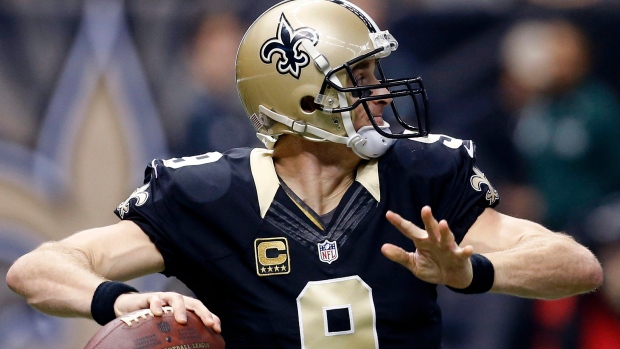Sep 6, 2016
Saints’ leaky defence ruining twilight of Brees’ career
Drew Brees is still an elite quarterback at 37-years-old. But his late-career heroics will be all for naught; spoiled by a still lacklustre New Orleans Saints’ defence.

Assuming you use Tom Brady and Peyton Manning as the measuring sticks – and let’s face it, we all do – Drew Brees is more the former than the latter. On the spectrum of great but aging quarterbacks, Brees is far closer to putting up MVP-worthy seasons than he is to losing his job for parts of the year.
The 37-year-old Brees, entering his 11th season with the Saints, is showing no signs of slowing down. Brees led the league in passing and fell just shy of throwing for 5,000 yards on the year only because of a missed game due to injury. Still, his 15-game mark of 4,870 was the sixth-highest of his career and projected to be second-highest (5,195) over a full 16 games.
Brees’ touchdown numbers also fall in line with his career norm while his 11 interceptions tied the mark for lowest he’s had in a Saints uniform, albeit in one less game. While quarterbacks often defy the normal career arc, especially the great ones, it should be assumed Brees has at least a few more elite level seasons left in him, mirroring Brady, who is two years his senior.
Equally impressive is Brees’ consistent performance late in his career despite a weakened receiving corps. While Brandin Cooks has surpassed expectations as the 20th overall pick in the 2014 Draft, and is a legit No. 1 receiver, suggestions the rest of the receiving corps matches the talent and depth Brees enjoyed five years ago are premature. The biggest disparity is at tight end, where Coby Fleener’s mediocre performance in Indy hints he won’t make anyone forget Jimmy Graham, and the five-year, $35 million deal he signed as a free agent was on the steep end.
If the receiving corps isn’t what it was when the Saints were making the playoffs, the running game may actually be better. After a slow start to his career, Mark Ingram has proven over the last two seasons he’s a reliable ball-carrier, the type of bell cow the playoff Saints’ rarely enjoyed, and a solid receiving back to boot. Still just 26, Ingram should be a reliable producer through the end of Brees’ run. New Orleans also boasts an impressive offensive line that includes a trio of Pro Bowl contenders in Terron Armstead, Max Unger, and Zach Strief.
All the above adds up to New Orleans owning one of the league’s better offences , but the limelight of Brees’ Hall of Fame career will likely be ruined by a leaky defence. While Brady’s enjoyed a competitive roster in New England his entire career, and Manning went out on top on the back of Denver’s defence, Brees hasn’t enjoyed those luxuries the past couple seasons in New Orleans.
Outside of signing an aging James Laurinitis, the only real difference the unit brings into the new season, outside the draft, is a full offseason under new defensive coordinator Dennis Allen. Allen’s success in Denver five seasons ago suggest he could break the recent streak of rotating DCs in New Orleans; his tenure as head coach in Oakland suggest head coach Sean Payton could soon be looking for his sixth DC in his 12-year tenure running the Saints. The full-time Allen tenure didn’t get off to a good start when solid starting cornerback Keenan Lewis was released in the preseason, apparently a result of not being comfortable with Allen.
If the Saint’s defence is to improve on their league-worst numbers of a year ago, they’ll have to rely on their strengths: a solid secondary, although now without Lewis; and a pass rush with potential.
TSN.ca favourite and former Hamilton Tiger-Cats star Delvin Breaux leads the team’s secondary. The 26-year-old needed just one season to be recognized as one of the best at his craft south of the border. Breaux, alongside safeties Kenny Vaccaro and Jairus Byrd form the nucleus of a secondary with too much talent to repeat as the second-worst passing defence in the league, but they were all there last year as well.
The pass rush meanwhile has talent in Cameron Jordan, who finished with double digit sacks for the second time in his career last year, but needs more. If first round pick Sheldon Richardson lives up to his billing as the top interior pass rusher in the draft, the Saints could be on to something. And more pressure on opposing QBs could help the guys on the back line live up to their considerable skill and potential.
Despite the lack of drastic changes you’d expect a bottom-ranked unit to undertake in an offseason, it’s unlikely the Saints’ defence will be as bad as they were last year. But it’s even more unlikely they’ll make the considerable leap needed to take enough pressure off Brees and the offence and compete for a playoff spot in the improved NFC South.
